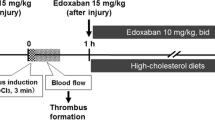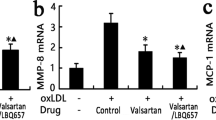Abstract
Objective
To determine the fractalkine expression in the aorta of ApoE −/− mice and the effect of high-dose aspirin intervention on fractalkine expression and atherosclerotic lesion formation.
Methods
Twenty-one male ApoE gene knockout mice were randomized into three groups to receive either placebo in addition to normal mice chow (n = 7), placebo in addition to a high-fat diet (n = 7), or aspirin (58 mg/kg/d) in addition to a high-fat diet (n = 7). After 12 weeks of study, the mice were euthanized and serum cholesterol, thromboxane B2, and \( 6 - {\text{keto}} - {\text{PG}}{{\text{F}}_{1\alpha }} \) were examined. Fractalkine and cyclooxygenase expression in aorta were measured and the atherosclerotic lesion analyzed.
Results
Pathology image analysis showed that the atherosclerotic plaque was the most extensive in the high-fat diet group while the addition of aspirin greatly reduced the severity of the plaque. Both RT-PCR analysis and immunohistochemical analysis showed that fractalkine expression was the strongest in the high-fat diet group and was significantly decreased by aspirin treatment. Serum thromboxane B2 was lowered by aspirin while \( 6 - {\text{keto}} - {\text{PG}}{{\text{F}}_{1\alpha }} \) and cholesterol remained unchanged.
Conclusions
The results of our study indicate that high dose aspirin can improve the atherosclerotic lesion and suppress the fractalkine expression in murine aorta.





Similar content being viewed by others
References
Weber C, Schober A, Zernecke A. Chemokines: key regulators of mononuclear cell recruitment in atherosclerotic vascular disease. Arterioscler Thromb Vasc Biol. 2004;24:1997–2008.
Volger OL, Fledderus JO, Kisters N, et al. Distinctive expression of chemokines and transforming growth factor-β signaling in human arterial endothelium during atherosclerosis. Am J Pathol. 2007;171:326–37.
Hisanori U, Eda TB, Toshiro O. Fractalkine in vascular biology from basic research to clinical disease. Arterioscl Thromb Vasc Biol. 2004;24:34–9.
Khan Q, Mehta JL. Relevance of platelet-independent effects of aspirin to its salutary effect in atherosclerosis-related events. J Atheroscler Thromb. 2005;12:185–90.
Pan Y, Lloyd C, Zhou H, et al. Neurotactin, a membrane-anchored chemokine upregulated in brain inflammation. Nature. 1997;387:611–7.
Chakravorty SJ, Cockwell P, Girdlestone J, et al. Fractalkine expression in human renal inflammation. J Pathol. 2002;196:85–90.
Bazan JF, Bacon KB, Hardiman GJ. A new class of membrane bound chemokine with a CX3C motif. Nature. 1997;385:640–4.
Greaves DR, Häkkinen T, Lucas AD, et al. Linked chromosome 16q13 chemokines, macrophage-derived chemokine, fractalkine, and thymus- and activation-regulated chemokine, are expressed in human atherosclerotic lesions. Arterioscler Thromb Vasc Biol. 2001;21:923–9.
Wong BW, Wong D, McManus BM. Characterization of fractalkine (CX3CL1) and CX3CR1 in human coronary arteries with native atherosclerosis, diabetes mellitus, and transplant vascular disease. Cardiovasc Pathol. 2002;11:332–8.
Saederup N, Chan L, Lira SA, et al. Fractalkine deficiency markedly reduces macrophage accumulation and atherosclerotic lesion formation in CR2−/− mice: evidence for independent chemokine functions in atherogenesis. Circulation. 2008;117:1642–8.
Barlic J, Zhang Y, Murphy PM. Atherogenic lipids induce adhesion of human coronary artery smooth muscle cells to macrophages by up-regulating chemokine CX3CL1 on smooth muscle cells in a TNFα- NF-κB-dependent manner. J Biol Chem. 2007;282:19167–76.
Cheng C. Atherosclerotic lesion size and vulnerability are determined by patterns of fluid shear stress. Circulation. 2006;113:2744–53.
Chandrasekar B, Mummidi S, Perla R, et al. Fractalkine (CX3CL1) stimulated by nuclear factor κB (NF-κB)-dependent inflammatory signals induces aortic smooth muscle cell proliferation through an autocrine pathway. Biochem J. 2003;373:547–58.
Ahn SY, Cho CH, Park KG, et al. Tumor necrosis factor-α induces fractalkine expression preferentially in arterial endothelial cells and mithramycin A suppresses TNF-α-induced fractalkine expression. Am J Pathol. 2004;164:1663–72.
Koppe E, Ghosh S. Inhibition of NF-kappaB by sodium salicylate and aspirin. Science. 1994;265:956–9.
Goda S, Imai T, Yoshie O, et al. CX3C-chemokine, fractalkine-enhanced adhesion of THP-1 cells to endothelial cells through integrin-dependent and -independent mechanisms. J Immunol. 2000;164:4313–20.
Weber C, Erl W, Pietsch A, et al. Aspirin inhibits nuclear factor—κB mobilization and monocyte adhesion in stimulated human endothelial cells. Circulation. 1995;91:1914–7.
Cyrus T, Yao Y, Tung LX, et al. Stabilization of advanced atherosclerosis in low-density lipoprotein receptor-deficient mice by aspirin. Atherosclerosis. 2006;184:8–14.
Schulz C, Konrad I, Sauer S, et al. Effect of chronic treatment with acetylsalicylic acid and clopidogrel on atheroprogression and atherothrombosis in ApoE-deficient mice in vivo. Thromb Haemost. 2008;99:190–5.
Tous M, Ferré N, Vilella E, et al. Aspirin attenuates the initiation but not the progression of atherosclerosis in apolipoprotein E-deficient mice fed a high-fat, high-cholesterol diet. Basic Clin Pharmacol Toxicol. 2004;95:15–9.
Williams PC, Coffey MJ, Coles B, et al. In vivo aspirin supplementation inhibits nitric oxide consumption by human platelets. Blood. 2005;106:2737–43.
Pratico D, Cyrus T, Li H, et al. Endogenous biosynthesis of thromboxane and prostacyclin in 2 distinct murine models of atherosclerosis. Blood. 2000;96:3823–6.
Choi SH, Langenbach R, Bosetti F. Genetic deletion or pharmacological inhibition of cyclooxygenase-1 attenuate lipopolysaccharide-induced inflammatory response and brain injury. FASEB J. 2008;22:1491–501.
Torzewski J. C-Reactive protein and atherogenesis: new insights from established animal models. Am J Pathol. 2005;167:923–5.
Author information
Authors and Affiliations
Corresponding author
Additional information
This work was supported by the grants from the Hunan Provincial Natural Science Foundation (No.07JJ3039)
Rights and permissions
About this article
Cite this article
Liu, H., Jiang, D., Zhang, S. et al. Aspirin Inhibits Fractalkine Expression in Atherosclerotic Plaques and Reduces Atherosclerosis in ApoE Gene Knockout Mice. Cardiovasc Drugs Ther 24, 17–24 (2010). https://doi.org/10.1007/s10557-009-6210-7
Published:
Issue Date:
DOI: https://doi.org/10.1007/s10557-009-6210-7




